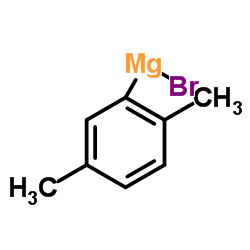Tris(2,5-dimethylphenyl)phosphine
Modify Date: 2025-08-22 21:13:12

Tris(2,5-dimethylphenyl)phosphine structure
|
Common Name | Tris(2,5-dimethylphenyl)phosphine | ||
|---|---|---|---|---|
| CAS Number | 115034-38-3 | Molecular Weight | 346.445 | |
| Density | N/A | Boiling Point | 467.2±45.0 °C at 760 mmHg | |
| Molecular Formula | C24H27P | Melting Point | 154-158ºC | |
| MSDS | N/A | Flash Point | 250.5±35.0 °C | |
| Name | Tris(2,5-dimethylphenyl)phosphine |
|---|---|
| Synonym | More Synonyms |
| Boiling Point | 467.2±45.0 °C at 760 mmHg |
|---|---|
| Melting Point | 154-158ºC |
| Molecular Formula | C24H27P |
| Molecular Weight | 346.445 |
| Flash Point | 250.5±35.0 °C |
| Exact Mass | 346.185028 |
| PSA | 13.59000 |
| LogP | 8.45 |
| Vapour Pressure | 0.0±1.1 mmHg at 25°C |
| InChIKey | KAAYGTMPJQOOGY-UHFFFAOYSA-N |
| SMILES | Cc1ccc(C)c(P(c2cc(C)ccc2C)c2cc(C)ccc2C)c1 |
Synonym:Tris(2,5-xylyl)phosphin Section 2 - COMPOSITION, INFORMATION ON INGREDIENTS
Risk Phrases: None Listed. Section 3 - HAZARDS IDENTIFICATION EMERGENCY OVERVIEW
Not available. Potential Health Effects Eye: May cause eye irritation. Skin: May cause skin irritation. May be harmful if absorbed through the skin. Ingestion: May cause irritation of the digestive tract. May be harmful if swallowed. Inhalation: May cause respiratory tract irritation. May be harmful if inhaled. Chronic: Not available. Section 4 - FIRST AID MEASURES Eyes: Flush eyes with plenty of water for at least 15 minutes, occasionally lifting the upper and lower eyelids. Get medical aid. Skin: Get medical aid. Flush skin with plenty of water for at least 15 minutes while removing contaminated clothing and shoes. Ingestion: Get medical aid. Wash mouth out with water. Inhalation: Remove from exposure and move to fresh air immediately. Notes to Physician: Treat symptomatically and supportively. Section 5 - FIRE FIGHTING MEASURES General Information: As in any fire, wear a self-contained breathing apparatus in pressure-demand, MSHA/NIOSH (approved or equivalent), and full protective gear. Extinguishing Media: Use water spray, dry chemical, carbon dioxide, or chemical foam. Section 6 - ACCIDENTAL RELEASE MEASURES General Information: Use proper personal protective equipment as indicated in Section 8. Spills/Leaks: Vacuum or sweep up material and place into a suitable disposal container. Section 7 - HANDLING and STORAGE Handling: Avoid breathing dust, vapor, mist, or gas. Avoid contact with skin and eyes. Storage: Store in a cool, dry place. Store in a tightly closed container. Section 8 - EXPOSURE CONTROLS, PERSONAL PROTECTION Engineering Controls: Use adequate ventilation to keep airborne concentrations low. Exposure Limits CAS# 115034-38-3: Personal Protective Equipment Eyes: Not available. Skin: Wear appropriate protective gloves to prevent skin exposure. Clothing: Wear appropriate protective clothing to prevent skin exposure. Respirators: Follow the OSHA respirator regulations found in 29 CFR 1910.134 or European Standard EN 149. Use a NIOSH/MSHA or European Standard EN 149 approved respirator if exposure limits are exceeded or if irritation or other symptoms are experienced. Section 9 - PHYSICAL AND CHEMICAL PROPERTIES Physical State: Powder Color: white Odor: Not available. pH: Not available. Vapor Pressure: Not available. Viscosity: Not available. Boiling Point: Not available. Freezing/Melting Point: 157 deg C Autoignition Temperature: Not available. Flash Point: Not available. Explosion Limits, lower: Not available. Explosion Limits, upper: Not available. Decomposition Temperature: Solubility in water: Specific Gravity/Density: Molecular Formula: C24H27P Molecular Weight: 346.45 Section 10 - STABILITY AND REACTIVITY Chemical Stability: Stable under normal temperatures and pressures. Conditions to Avoid: Incompatible materials. Incompatibilities with Other Materials: Strong oxidizing agents. Hazardous Decomposition Products: Carbon monoxide, oxides of phosphorus, carbon dioxide. Hazardous Polymerization: Will not occur. Section 11 - TOXICOLOGICAL INFORMATION RTECS#: CAS# 115034-38-3 unlisted. LD50/LC50: Not available. Carcinogenicity: Tris(2,5-dimethylphenyl)phosphine - Not listed by ACGIH, IARC, or NTP. Section 12 - ECOLOGICAL INFORMATION Section 13 - DISPOSAL CONSIDERATIONS Dispose of in a manner consistent with federal, state, and local regulations. Section 14 - TRANSPORT INFORMATION IATA Not regulated as a hazardous material. IMO Not regulated as a hazardous material. RID/ADR Not regulated as a hazardous material. Section 15 - REGULATORY INFORMATION European/International Regulations European Labeling in Accordance with EC Directives Hazard Symbols: Not available. Risk Phrases: Safety Phrases: S 24/25 Avoid contact with skin and eyes. WGK (Water Danger/Protection) CAS# 115034-38-3: No information available. Canada None of the chemicals in this product are listed on the DSL/NDSL list. CAS# 115034-38-3 is not listed on Canada's Ingredient Disclosure List. US FEDERAL TSCA CAS# 115034-38-3 is not listed on the TSCA inventory. It is for research and development use only. SECTION 16 - ADDITIONAL INFORMATION N/A |
| Hazard Codes | Xn: Harmful; |
|---|---|
| Risk Phrases | R22 |
|
~56% 
Tris(2,5-dimeth... CAS#:115034-38-3 |
| Literature: Journal of Organic Chemistry, , vol. 56, # 11 p. 3537 - 3542 |
|
~% 
Tris(2,5-dimeth... CAS#:115034-38-3 |
| Literature: Justus Liebigs Annalen der Chemie, , vol. 315, p. 100 |
| Tris(2,5-dimethylphenyl)phosphine |
| tris(2,5-dimethylphenyl)phosphane |
| Phosphine, tris(2,5-dimethylphenyl)- |

